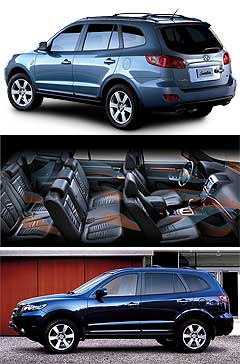First look: Hyundai gives Santa claws!
BY NEIL MCDONALD | 25th Nov 2005

That’s the message from the Korean car-maker as it prepares the newcomer for a local launch mid-2006. Hyundai chairman and CEO, Chung Mong-Koo expects the 2006 Santa Fe to appeal to a wider buyer audience.
Visually it loses the clumsy curves of the old car, opting instead for a restrained and streamlined Euro-look.
Codenamed CM, the Santa Fe took 26 months to develop and cost $US155 million ($A210 million).
The off-roader is bigger in every respect the current car – 175mm longer, 55mm wider and 50mm higher – while riding on a longer 2700mm-wheelbase.
The bigger footprint has freed up interior room with greatly increased front and rear legroom and allowed the addition of a third-row, fold-flat rear seat.
Although local specifications and trim levels are yet to be decided, three engines will be available in Korea – a 2.2-litre turbo-diesel, 2.7-litre petrol and 3.3-litre Lamba V6, shared with the new Sonata sedan.
A petrol-electric hybrid is also believed to be in the pipeline. Both V6s have variable valve timing and a variable intake system. The 2.7 will offer either a five-speed manual or four-speed automatic while the 3.3-litre will be a five-speed sequential automatic only.
The 2.7-litre develops 140kW at 6000rpm and 248Nm at 4200rpm while the 3.3-litre is sure to up the ante, given that the same engine in the Sonata develops 173kW at 6000rpm and 304Nm at 3500rpm.
The Euro IV compliant common-rail turbo-diesel develops 114kW at 4000rpm and 343Nm at 2000rpm with the help of a variable geometry turbocharger. It is mated to an all-new sequential five-speed transmission.
Hyundai has given the Santa Fe a new electronically-controlled four-wheel drive system that automatically varies drive to the wheels.
A driver-selectable 4WD lock provides a continuous 50/50 torque split between front and rear wheels for tough off-road situations. Hyundai claims the Santa Fe’s chassis has been extensively revised to achieve more refined car-like ride and handling dynamics.
The predecessor’s double wishbone rear suspension has been dropped in favour of a sophisticated multi-link set-up that it claims is quieter and offers a better rear passenger ride. The rear suspension boasts an automatic self-levelling system that adjusts to heavy loads.

Safety equipment abounds with standard ABS and optional Electronic Stability Program. A front passenger seat airbag cut-off switch enables the front passenger seat airbag to be de-activated in case a child-seat is installed.
Active headrests for the front seats are also new to the range as is a seat-mounted three-point centre rear seatbelt in the second row.
Apart from the dual front airbags, the Santa Fe offers front seat mounted side airbags and curtain airbags that, like the Ford Territory and Volvo XC90, deploy along the entire length of the vehicle, extending head protection to the third row passengers.
Other thoughtful touches include power adjustable pedals, dual zone climate control, rain-sensing automatic wipers, trip computer, heated exterior mirrors and windscreen de-icing system.
The Santa Fe will be built at the company’s Ulsan plant in Korea.